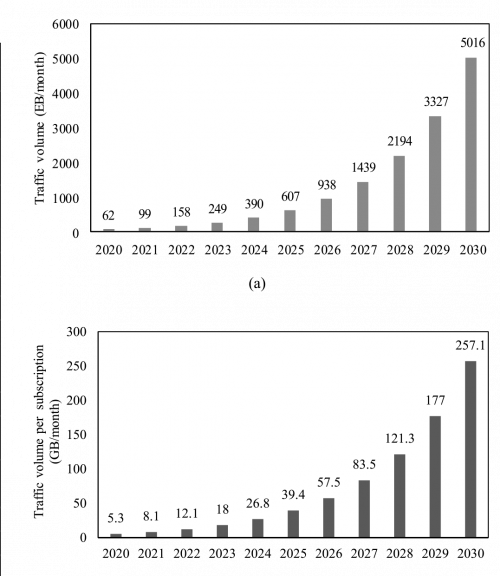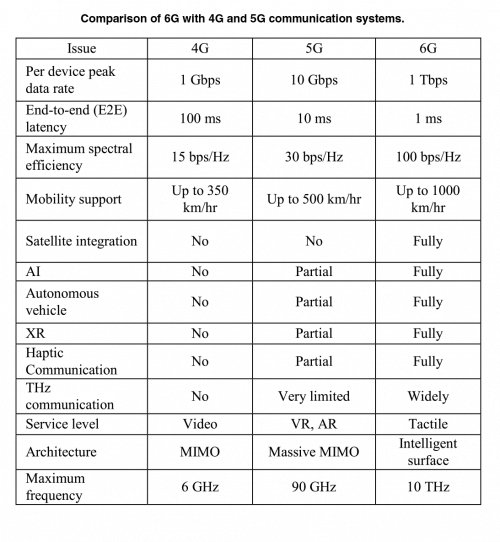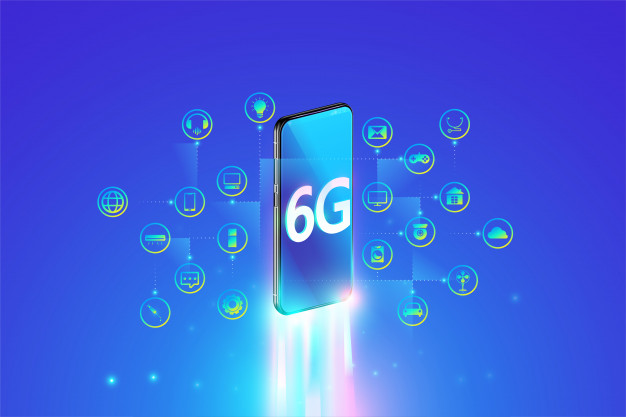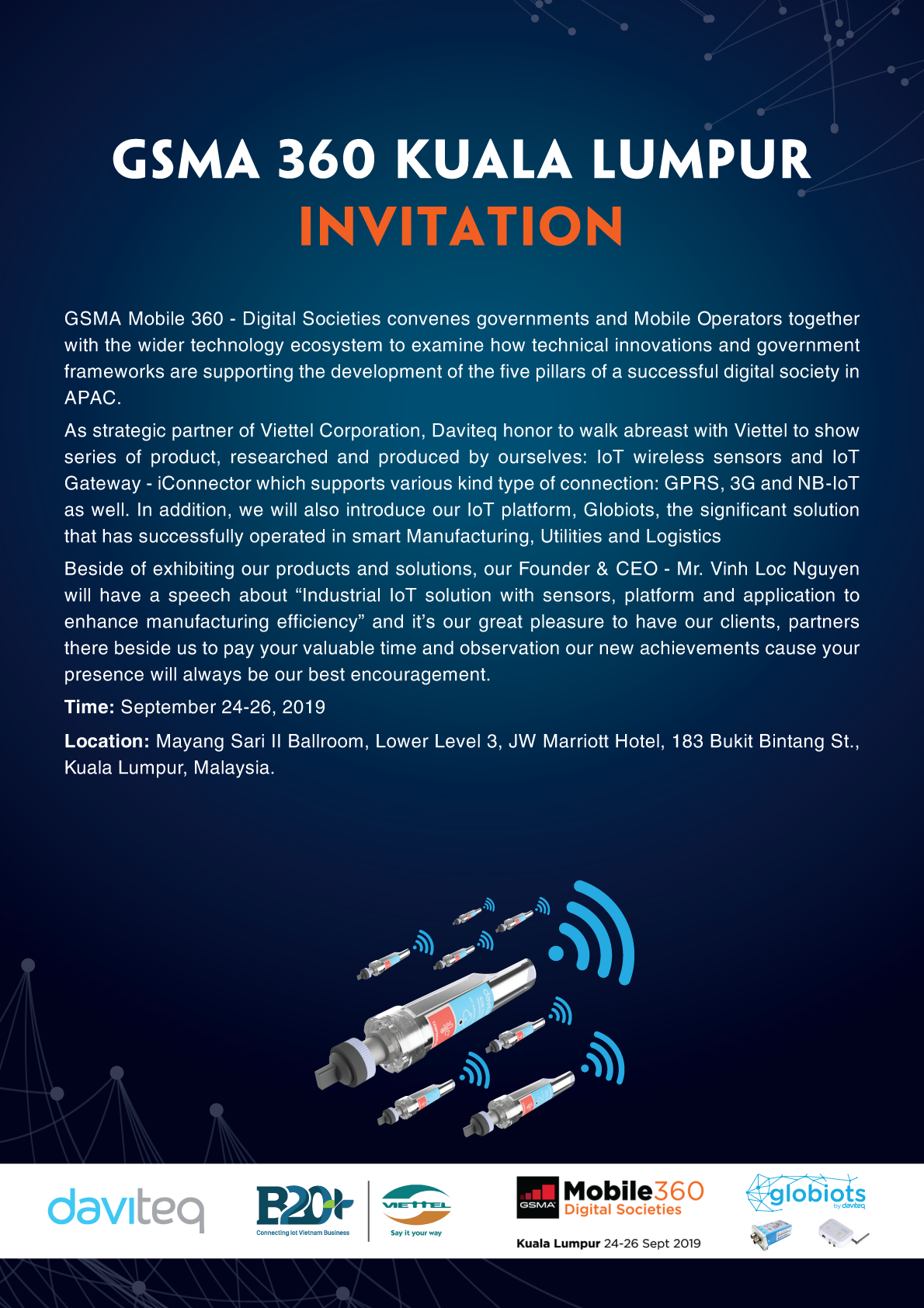The demand for wireless connectivity has grown exponentially over the last few decades. Fifth-generation (5G) communications, with far more features than fourth-generation communications, will soon be deployed worldwide. A new paradigm of wireless communication, the sixth-generation (6G) system, with the full support of artificial intelligence, is expected to be implemented between 2027 and 2030.
Beyond 5G, some fundamental issues that need to be addressed are higher system capacity, higher data rate, lower latency, higher security, and improved quality of service (QoS) compared to the 5G system. This paper presents the vision of future 6G wireless communication and its network architecture.
This article describes emerging technologies such as artificial intelligence, terahertz communications, wireless optical technology, free-space optical network, blockchain, three-dimensional networking, quantum communications, uncrewed aerial vehicles, cell-free communications, integration of wireless information and energy transfer, integrated sensing and communication, integrated access-backhaul networks, dynamic network slicing, holographic beamforming, backscatter communication, intelligent reflecting surface, proactive caching, and big data analytics that can assist the 6G architecture development in guaranteeing the QoS.
Besides, expected applications with 6G communication requirements and possible technologies are presented. We also describe potential challenges and research directions for achieving this goal.
TRENDS IN MOBILE COMMUNICATIONS
Since the beginning of the first analogue communication system in the 1980s, a new generation of communication systems has been introduced almost every ten years. The transfer from one generation to another improves the QoS metrics, includes new services, and provides new features.
The goal of B5G and 6G is to increase in the respective capability by a factor of 10–100 compared to the previous mobile generation upgrades. During the last ten years, mobile data traffic has grown tremendously because of the introduction of smart devices and machine-to-machine (M2M) communications.

FIGURE 1. The predicted growth of global mobile connectivity during 2020-2030 (By Dr Ping Yang & Yue Xiao).
(a) total global traffic volume, (b) traffic volume per subscription.
Fig. 1 shows the exponential growth of mobile connectivity. It is expected that the global mobile traffic volume will increase 670 times in 2030 compared to mobile traffic in 2010, according to ITU (International Telecommunication Union). By the end of 2030, the International Telecommunication Union (ITU) predicts overall mobile data traffic will exceed 5 ZB per month. The number of mobile subscriptions will reach 17.1 billion as compared with 5.32 billion in 2010.
Moreover, the use of M2M connectivity will also increase exponentially. The traffic volume for each of the mobile devices will also increase. The traffic volume of a mobile device in 2010 was 5.3 GB per month. However, this volume will grow 50 times in 2030. The number of M2M subscriptions will increase 33 times in 2020 and 455 times in 2030, as compared with 2010. Recently, research interests have shifted to data-driven adaptive and intelligent methods. As stated by the IEEE journal in 2017, the 5G wireless networks will build a foundation of intelligent networks that provide AI operations. It is estimated in a study on arXIV magazine that by 2030, the capacity of 5G will reach its limit.
Then, sufficiently intelligent network adaptation and management for providing advanced services will only be realized using 6G networks.
Hence, 6G wireless communication is the result of the user needs growing beyond what the 5G network can offer. Researchers worldwide are already studying what 6G communications would be like in 2030; they are also looking at the possible drivers for successful 6G wireless communications. A few of the critical motivating trends behind the evolution of 6G communication systems are as follows: high bit rate, high reliability, low latency, high energy efficiency, high spectral efficiency, new spectra, green communication, intelligent networks, network availability, communications convergence, localization, computing, control, and sensing. Therefore, 6G will be a world of fully digital connectivity.
SPECIFICATIONS AND REQUIREMENTS:
5G technologies are associated with trade-offs of several issues, such as throughput, delay, energy efficiency, deployment costs, reliability, and hardware complexity. Likely, 5G will not be able to meet the market demands after 2030. Then, 6G will fill the gap between 5G and market demand.
Based on the previous trends and predictions of future needs, the main objectives for the 6G systems are (1) extremely high data rates per device, (2) a vast number of connected devices, (3) global connectivity, (4) very low latency, (5) lowering the energy consumption with battery-free Internet of Things (IoT) devices, (6) ultra-high reliable connectivity, and (7) connected intelligence with machine learning capability. The table below shows a comparison of 6G with the 4G and 5G communication systems. It is anticipated that 6G will require a new key performance indicator (KPI) driver besides the KPIs of 5G communication systems. Many KPIs of the 5G network will also be valid for 6G. However, the 5G KPIs must be reviewed, and new KPIs must be considered for 6G.

A. SERVICE REQUIREMENTS
The 6G communication systems are expected to be featured by the following types of KPI associated services, as mentioned by IEEE Internet of Things Journal:
- Ubiquitous mobile ultra-broadband (uMUB)
- Ultra-high-speed with low-latency communications (uHSLLC)
- Massive machine-type communication (mMTC)
- Ultra-high data density (uHDD)
The following key factors will characterize the 6G communication system:
- AI integrated communication
- Tactile Internet
- High energy efficiency
- Low backhaul and access network congestion
- Enhanced data security
It is estimated that the 6G system will have 1000 times higher simultaneous wireless connectivity than the 5G system.
B. NEW NETWORK CHARACTERISTICS
Satellite Integrated Network: Satellite communication is a must to provide ubiquitous connectivity. Geographical circumstances almost unconstrain it. It can support a seamless global coverage of various geographic locations such as land, sea, air, and sky to serve the user’s ubiquitous connectivity. Hence, to provide always-on broadband global mobile collectivity, it is expected to integrate terrestrial and satellite systems to achieve the goal of 6G. Integrating terrestrial, satellite, and airborne networks into a single wireless system will be crucial for 6G.
Connected Intelligence: In contrast to the earlier generation of wireless communication systems, 6G will be transformative, and will update the wireless advancement from “connected things” to “connected intelligence”, according to a Hong Kong Science and Technology’s research. AI will be introduced in each step of the communication process as well as radio resource management.
Seamless Integration of Wireless Information and Energy Transfer: The 6G wireless networks will also transfer power to charge battery devices, such as smartphones and temperature sensor. Hence, wireless information and energy transfer (WIET) will be integrated.
Ubiquitous Super 3D Connectivity: Accessing the network and core network functionalities on drones and very low earth orbit satellites will make the super-3D connectivity in 6G universal.
CHALLENGES AND FUTURE RESEARCH DIRECTIONS
Several technical problems need to be solved to deploy 6G communication systems successfully. A few possible concerns are briefly discussed below.
- High Propagation and Atmospheric Absorption of THz: The high THz frequencies provide high data rates. However, the THz bands need to overcome a significant challenge for data transfer over relatively long distances because of the high propagation loss and atmospheric absorption characteristics, as stated by Dr Shahid Mumtaz. We require a new design for the transceiver architecture for the THz communication systems. The transceiver must be able to operate at high frequencies, and we need to ensure the full use of very widely available bandwidths.
- Complexity in Resource Management for 3D Networking: The 3D networking extended in the vertical direction. Hence, a new dimension was added. Moreover, multiple adversaries may intercept legitimate information, which may significantly degrade overall system performance.
- Heterogeneous Hardware Constraints: In 6G, a vast number of mixed types of communication systems, such as frequency bands, communication topologies, service delivery, and many more will be involved. Moreover, the access points and mobile terminals will be significantly different in the hardware settings.
- Autonomous Wireless Systems: The 6G network will provide full support to automation systems such as an autonomous vehicle, UAVs, and Industry 4.0 based on AI. It is also listed on Nature Electronics Magazine that to make autonomous wireless systems; we need to have the convergence of many heterogeneous sub-systems, such as autonomous computing, interoperable processes, the system of systems, machine learning, autonomous cloud, machines of systems, and mixed wireless systems.
- Modelling of Sub-mmWave (THz) Frequencies: The propagation characteristics of the mmWave and submmWave (THz) is subject to atmospheric conditions; therefore, absorptive and dispersive effects are seen, as claimed by Journal of Applied Physics.
- Device Capability: The 6G system will provide several new features. Devices, such as smartphones, should have the ability to cope with the new features. In particular, it is challenging to support Tbps throughput, AI, XR, and integrated sensing with communication features using individual devices.
- High-Capacity Backhaul Connectivity: The access networks in 6G will have a very high density. Moreover, these access networks are diverse and widespread within a geographical location. Each of these access networks will support very high-data-rate connectivity for different types of users. The backhaul networks in 6G must handle the enormous volumes of data for connecting between the access networks and the core network to support high-data-rate services at the user level; otherwise, a bottleneck will be created.
Enhance your Wireless Technology with Daviteq
Each generation of communication system brings new and exciting features. The 5G communication system, which will be officially launched worldwide in 2020, has impressive features. However, 5G will not be able to support the growing demand for wireless communication in 2030 entirely. Therefore, 6G needs to be rolled out. Research on 6G is still in its infancy and the study phase. This paper envisions the prospects and ways to reach the goal of 6G communication. In this article, we presented the possible applications and the technologies to be deployed for 6G communication. We also described the potential challenges and research directions to reach the goals for 6G.
“Besides clarifying the vision and purpose of 6G communications, we have stated the various technologies that can be used for 6G communication.”


 Tiếng Việt
Tiếng Việt



